Figure 1. Map of Spitsbergen.

Figure 2. Lithostratigraphy of central Spitsbergen.

Figure 3. Kolosseum section, with samples marked.

Figure 4. Fusulinid distributions in the Kolosseum section. All specimens from this collection are housed in the Oslo Paleontological Museum (PMO), collection number 43865.
| Fusulinid Zonation | Fusulinella bocki Zone |
Protriticites ex. gr. ovatus Quasifusulinoides quasifusulinoides Zone |
Protriticites pseudomontiparus Obsoletes obsoletus Zone |
Montiparus montiparus Zone |
|||||||
| Taxa \ Sample | KOL-28.3 | KOL-29.5 | KOL-38.0 | KOL-66.0 | KOL-76.0 | KOL-79.0 | KOL-81.0 | KOL-82.0 | KOL-87.5 | KOL-91.5 | KOL-95.5 |
| 1. Fusulinella bocki | x | x | x | x | |||||||
| 2. Fusulinella helenae | x | x | x | ||||||||
| 3. Wedekindellina dutkevichi | x | x | x | ||||||||
| 4. Beedeina elshanica | x | ||||||||||
| 5. Beedeina paradistenta | x | ||||||||||
| 6. Beedeina samarica | x | x | |||||||||
| 7. Fusulinella cf. bocki | x | x | x | ||||||||
| 8. Fusulinella mosquensis | x | ||||||||||
| 9. Beedeina distenta | x | ||||||||||
| 10. Eowaeringella? sp. | x | ||||||||||
| 11. Fusiella typica | x | x | |||||||||
| 12. Fusulinella sp. | x | x | |||||||||
| 13. Neostraffella sphaeroidea | x | ||||||||||
| 14. Protriticites ex gr. globulus | x | ||||||||||
| 15. Protriticites? sp. | x | x | |||||||||
| 16. Pseudofusulinella? eopulchra | x | x | x | x | x | ||||||
| 17. Quasifusulinoides? eopulchra | x | ||||||||||
| 18. Quasifusulinoides? intermedius | x | ||||||||||
| 19. Quasifusulinoides? kolensis | x | ||||||||||
| 20. Pseudofusulinella? pulchra | x | x | x | x | |||||||
| 21. Fusulina mosquensis | x | x | |||||||||
| 22. Protriticites aff. sphaericus | x | x | x | ||||||||
| 23. Protriticites ex gr. ovatus | x | x | |||||||||
| 24. Pseudofusulinella? ylychensis | x | ||||||||||
| 25. Quasifusulinoides blear | x | x | x | ||||||||
| 26. Quasifusulinoides firmus | x | x | |||||||||
| 27.Quasifusulinoides fusiformis | x | x | x | ||||||||
| 28. Quasifusulinoides quasifusulinoides | x | ||||||||||
| 29. Quasifusulinoides sp. | x | x | x | ||||||||
| 30. Quasifusulinoides fusulinoides | x | ||||||||||
| 31. Quasifusulinoides? fortissimum | x | x | |||||||||
| 32. Fusiella ex gr. rawi | x | x | |||||||||
| 33. Fusulina pachrensis | x | ||||||||||
| 34. Praeobsoletes sp. | x | ||||||||||
| 35. Protriticites aff. plicatissimum | x | ||||||||||
| 36. Protriticites ovatus | x | x | x | ||||||||
| 37. Protriticites plicatus | x | x | |||||||||
| 38. Protriticites pseudomontiparus | x | x | |||||||||
| 39. Protriticites sphaericus | x | x | x | ||||||||
| 40. Protriticites variabilis | x | ||||||||||
| 41. Pseudofusulinella aff. usvae | x | ||||||||||
| 42. Fusiella rawi | x | ||||||||||
| 43. Fusulinella to Praeobsoletes | x | ||||||||||
| 44. Obsoletes fusiformis | x | ||||||||||
| 45. Praeobsoletes burkemensis | x | ||||||||||
| 46. Praeobsoletes to Obsoletes | x | ||||||||||
| 47. Protriticites subovatus | x | ||||||||||
| 48. Protriticites ovoides | x | ||||||||||
| 49. Protriticites to Montiparus | x | ||||||||||
| 50. Protriticites Subschwagerinoides | x | ||||||||||
| 51. Motiparus calitvicus | x | ||||||||||
| 52. Montiparus likharevi | x | ||||||||||
| 53. Montiparus mesopachus | x | ||||||||||
| 54. Montiparus montiparus | x | ||||||||||
| 55. Montiparus umbonoplicatus | x | ||||||||||
| 56. Montiparus sp. | x | ||||||||||
| 57. Protriticites lamellosus | x | ||||||||||
| 58. Protriticites manukalovae | x | ||||||||||
| 59. Pseudofusulinella usvae | x | ||||||||||
| 60. Quasifusulina aff. eleganta | x | ||||||||||
| 61. Quasifusulina ex gr. longissima | x | ||||||||||
| 62. Quasifusulina sp. | x | ||||||||||
| 63. Quasifusulina sp. nov. | x | ||||||||||
Figure 5.1-20. Fusulinid assemblage of Fusulinella bocki Zone, all figures from bed 38.5 m. 1. Fusiella cf. typica Lee and Chen 1930, scale bar = 88mm, (PMO-43865/14a), oblique section; 2-4. Neostaffella sphaeroidea(Ehrenberg em. Moeller 1878), 2. scale bar = 88mm, axial section of young specimen, (PMO-43865/14a); 3. scale bar = 44mm, oblique axial section, (PMO-43865/22a); 4. scale bar = 66mm, oblique axial section, (PMO-43865/14a). 5. Neostaffella cf. paradoxa (Dutkevich 1934a), scale bar = 88mm, oblique axial section, (PMO-43865/22a). 6-7. Wedekindellina uralica (Dutkevich 1934b), 6. scale bar = 44mm, axial sections, (PMO-43865/14a); 7. scale bar = 88mm, axial section, (PMO-43865/9a). 8. Wedekindellina subovata Safonova 1951, scale bar = 88mm, near axial section, (PMO-43865/18a). 9. Beedeina samarica (Rauser and Belyaev in Rauser-Chernousova, Belyaev, and Reitlinger 1937), scale bar = 33mm, oblique axial section, (PMO-43865/10a). 10. Beedeina elegans (Rauser 1951), scale bar = 33mm, near axial section, (PMO-43865/4a). 11-14. Quasifusulinoides? kolensis (Nilsson 1988 msc.), scale bar = 22mm, axial sections 11. (PMO-43865/21a); 12. (PMO-43865/12a); 13. (PMO-43865/1a); 13a. scale bar = 88mm, enlargement of figure 6-13, wall structure with tectum, gray diaphanotheca and dark inner tectorium; 14. (PMO-43865/18a); 14a, scale bar = 88mm, enlargement of figure 6-14. 15-16. Pseudofusulinella? pulchra (Rauser and Belyaev in Rauser-Chernousova, Belyaev, and Reitlinger 1937), scale bar = 33mm 15. near axial section, (PMO-43865/8a); 16. axial section, (PMO-43865/6a). 17-18. Pseudofusulinella? eopulchra (Rauser 1951), scale bar = 33mm, both axial section 17. (PMO-43865/3a); 18. (PMO-43865/14a). 19-20. Fusulinella bocki(Moeller 1878) 19. scale bar = 66mm, axial section, (PMO-43865/10a); 20. scale bar = 33mm, oblique axial section, (PMO-43865/6a); 20a enlargement of figure 6-20, scale bar = 110mm, typical Fusulinella wall structure with tectum, light diaphanotheca and dark inner and outer tectorium.
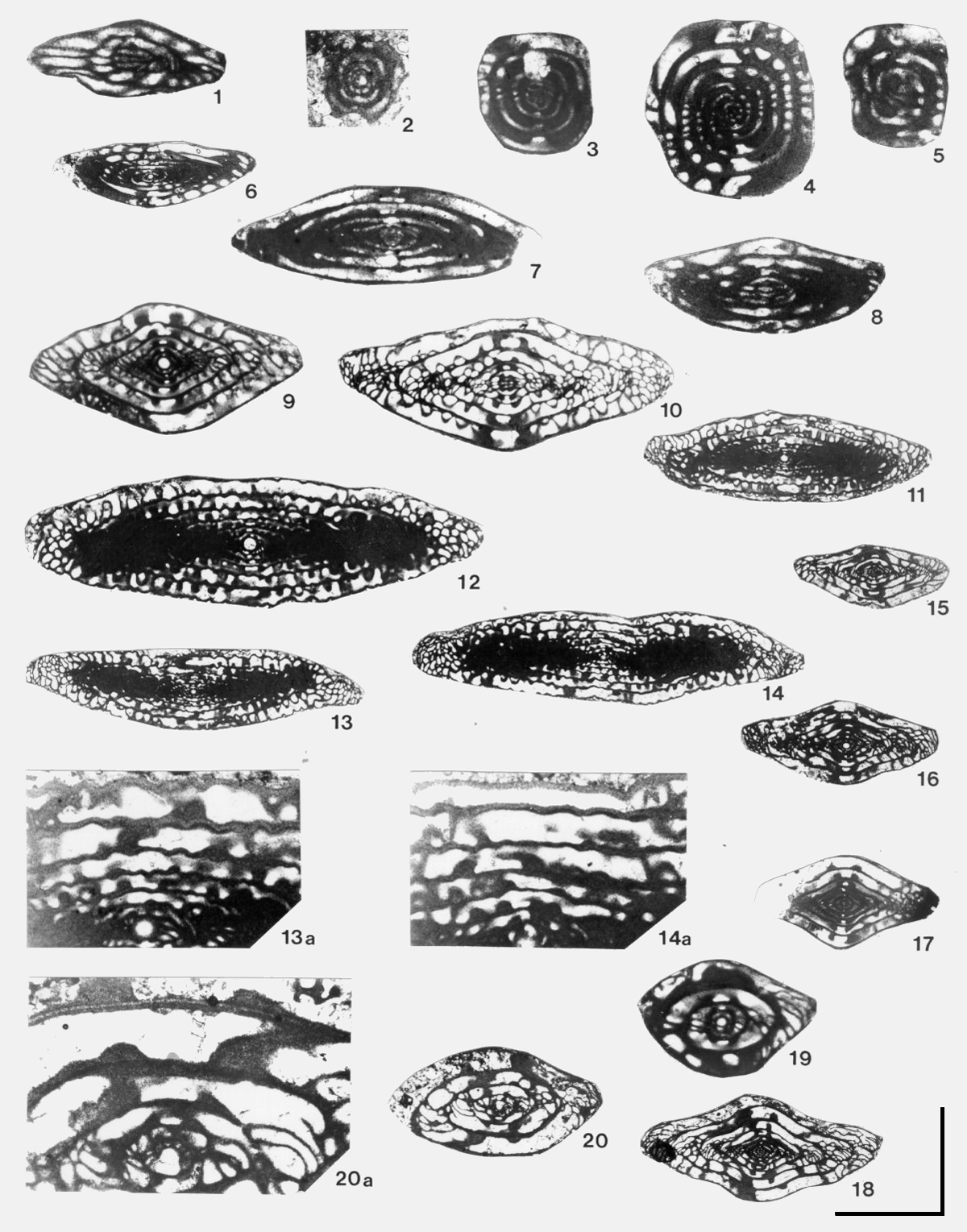
Figure 6.1-18. Fusulinid assemblage of Protriticites ex gr. ovatus-Quasifusulinoides quasifusulinoides Zone. 1. Fusiella praelancetiformis Safonova 1951, scale bar = 88mm, axial section, bed 76.0 m, (PMO-43859/A1a). 2. Fusiella praecursor Rauser 1951, scale bar = 88mm, axial section, bed 76.0 m, (PMO-43859/1a). 3. Fusiella typica Lee et Chen 1934, scale bar = 110mm, axial section, bed 76.0 m, (PMO-43859/2a). 4. Beedeina mosquensis (Rauser 1951), scale bar = 22mm, axial section, bed 66.0 m, (PMO-43860/1a); 4a, enlargement of figure 7-4, scale bar = 88mm, typical Beedeina wall structure with tectum, light diaphanotheca and dark inner and outer tectorium. 5. Quasifusulinoides firmus (Rauser 1951), scale bar = 22mm, axial section of incomplete specimen, bed 76.0 m, (PMO-43859/B1a); 5a, enlargement of figure 7-5, scale bar = 88mm, wall structure with tectum, indistinct diaphanotheca and dark inner tectorium with well developed pores. 6-7. Quasifusulinoides fusiformis (Rosovskaya,1952), scale bar = 22mm, both axial sections, 6, bed 76.0 m, (PMO-43859/9a); 7, bed 79.0 m, (PMO-43858/12a). 8-9. Pseudofusulinella? eopulchra (Rauser 1951), scale bar = 22mm, both axial sections, 8, bed 79.0 m, (PMO-43858/1a); 9, bed 76.0 m, (PMO-43858/D1a). 10. Fusulinella helenae Safonova 1951, scale bar = 33mm, near axial section, bed 79.0 m, (PMO-43858/14a); 10a, enlargement of figure 7-10, scale bar = 110mm, wall structure with tectum, diaphanotheca and dark inner and outer tectorium. 11-12. Fusulinella bocki Moeller,1878, scale bar = 33mm, both axial sections, bed 79.0 m, 11, (PMO-43858/25a); 12, (PMO-43858/6a). 13. Fusulinella timanica Rauser 1951, scale bar = 33mm, axial sections, bed 79.0 m, (PMO-43858/8a). 14-17. Transitional specimens from Fusulinella to Protriticites, scale bar = 33mm, all axial sections, 14, bed 79.0 m, (PMO-43858/15a); 15, bed 79.0 m, (PMO-43858/3a); 15a, enlargement of figure 7-15, scale bar = 110mm, primitive Protriticites wall structure with tectum, indistinct diaphanotheca and inner tectorium; small poor developed pores penetrate throughout the wall; 16, bed 76.0 m, (PMO-43858/14a); 16a, enlargement of figure 7-16, scale bar = 110mm, primitive Protriticites wall structure with tectum, very thin but distinct diaphanotheca and inner tectorium with thin pores throughout the wall; 17, bed 79.0 m, (PMO-43858/22a). 18. Protriticites ex gr. inflatus Bensh 1972, scale bar = 33mm, axial section, bed 79.0 m, (PMO-43858/2a).
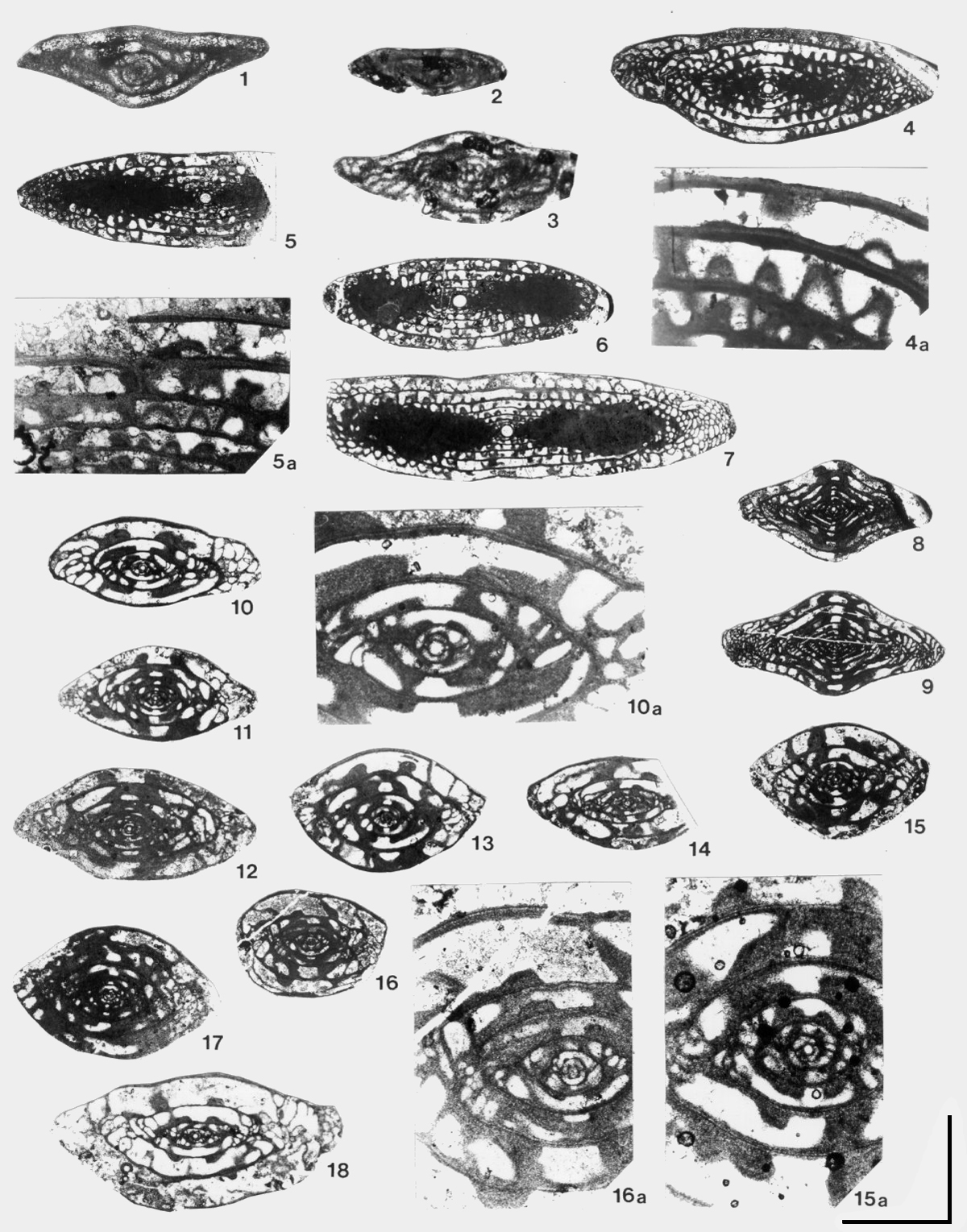
Figure 7.1-21. Fusulinid assemblage of Protriticites pseudomontiparus, Obsoletes obsoletus Zone. 1. Fusiella lancetiformis Putrya 1939, scale bar = 88mm, axial section, bed 87.5 m, (PMO-43856/16a). 2. Fusiella rawi Lee 1927, scale bar = 88mm, axial section, bed 87.5 m, (PMO-43856/23a). 3-6. Quasifusulinoides fusiformis (Rosovskaya 1952), scale bar = 33mm, all axial sections, 3, bed 87.5 m, (PMO-43856/15a); 3a, enlargement of figure 8-3, scale bar = 110mm, Quasifusulinoides wall structure with tectum, indistinct diaphanotheca and dark inner tectorium with well developed coarse pores; 4, bed 81.0 m, (PMO-43861/4a); 5, bed 81.0 m, (PMO-43861/14a); 6, bed 81.0 m, (PMO-43861/15a). ). 7. Quasifusulinoides fortissimus (Rauser,1951), scale bar = 22mm, axial section, bed 81.0 m, (PMO-43861/30a). 8. Quasifusulinoides sp., x50, inner volutions, wall structure with tectum, primatheca and dark inner tectorium with well developed coarse pores, bed 81.0 m, (PMO-43861/5a). 9-10. Pseudofusulinella? pulchra (Rauser and Belyaev in Rauser-Chernousova, Belyaev, and Reitlinger 1937), scale bar = 22mm, both axial sections; 9. bed 81.0 m, (PMO-43861/24a); 10. bed 87.5 m, (PMO-43856/9a). 11. Fusulinella bocki Moeller 1878, scale bar = 33mm, axial section, bed 81.0 m, (PMO-43861/1a). 12. Fusulinella pseudobocki Lee and Chen 1934, scale bar = 33mm, axial section, bed 81.0 m, (PMO-43861/32a). 13. Protriticites pseudomontiparus Putrja 1948, scale bar = 33mm, axial section, bed 81.0 m, (PMO-43861/16a). 14. Protriticites ovatus Putrja 1948, scale bar = 33mm, axial section, bed 81.0 m, (PMO-43861/24a). 15. Protriticites variabilis Bensh 1972, scale bar = 33mm, axial section, bed 81.0 m, (PMO-43861/8a). 16-17. Protriticites sphaericus Volozhanina 1962, scale bar = 33mm, both axial sections, bed 81.0 m, 16, (PMO-43861/5a); 17, (PMO-43861/26a). ). 18. and 20. Praeobsoletes burkemensis (Volozhanina 1962), scale bar = 33mm, both axial sections, bed 81.0 m, 18, (PMO-43861/3a);20. (PMO-43861/12a); 20a, enlargement of figure 8-20, scale bar = 110mm, Praeobsoletes wall structure with Fusulinella type wall in inner volutions (dark tectum, light diaphanotheca, inner and outer tectoriums) and with tectum and very thin gray primatheca with poor developed pores in outer volution. 19. Protriticites plicatissimus Kireeva 1950, scale bar = 33mm, axial section, bed 81.0 m, (PMO-43861/25a). 21. Protriticites plicatus Kireeva 1950, scale bar = 33mm, axial section, bed 81.0 m, (PMO-43861/34a); 21a, enlargement of figure 8-21, scale bar = 110mm, Protriticites wall structure composed in outer volution dark tectum, indistinct gray diaphanotheca, which became disappear, thin outer tectorium and relatively thick outer tectorium with well developed pores.
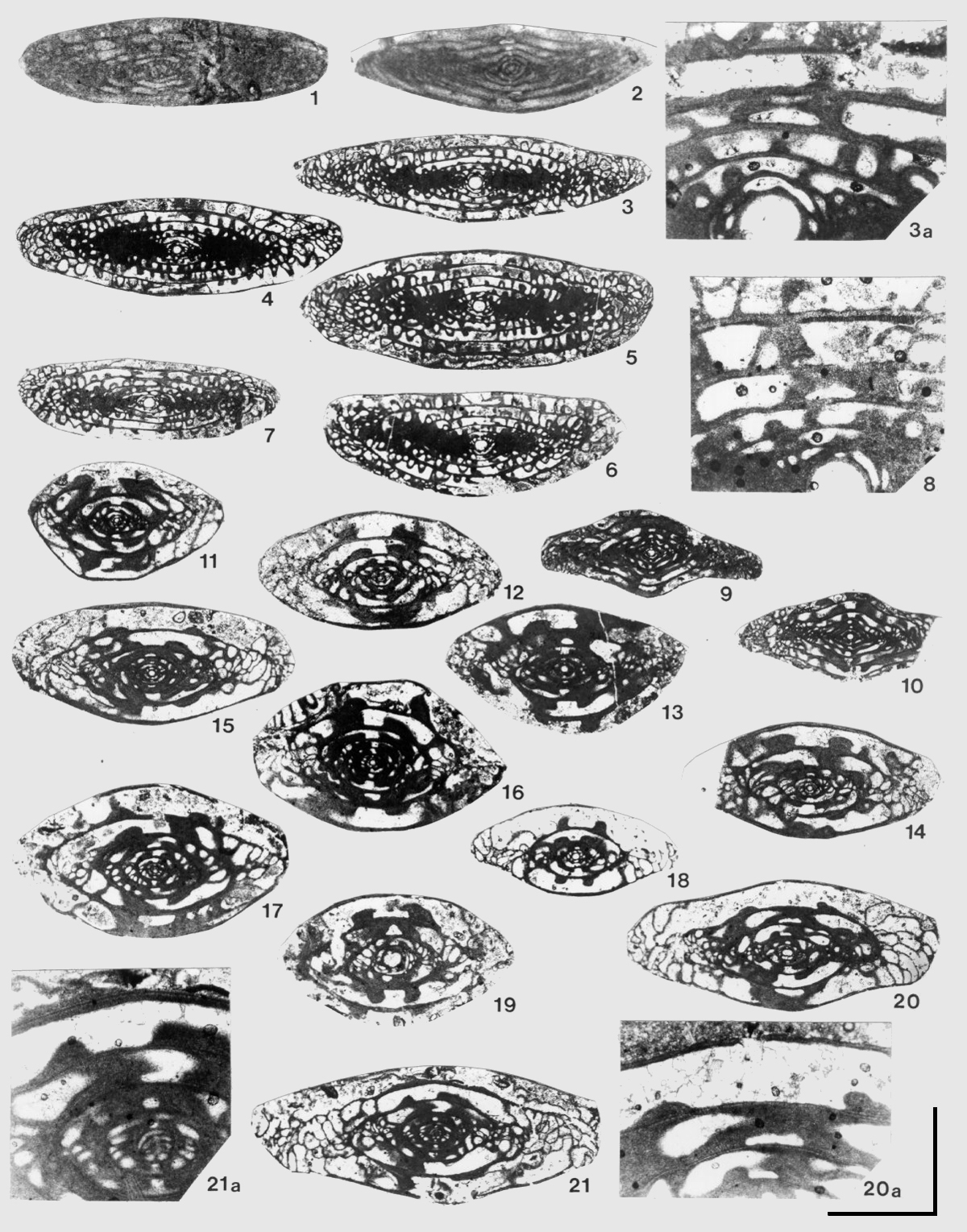
Figure 8.1-13. Fusulinid assemblage of Protriticites pseudomontiparus, Obsoletes obsoletus Zone. 1. Pseudofusulinella usvae (Dutkevich 1934b), scale bar = 22mm, axial section, bed 91.5 m, (PMO-43862/2a). 2. Praeobsoletes burkemensis (Volozhanina 1962), scale bar = 33mm, axial section, bed 91.5 m, (PMO-43862/18a); 2a, enlargement of figure 9-2, scale bar = 110mm, Praeobsoletes wall structure with Fusulinella type wall in first and second volutions (dark tectum, light diaphanotheca, inner and outer tectoriums) and with tectum and thin primatheca with developed pores in outer two volutions. 3. Obsoletes fusiformis Bensh 1972, scale bar = 33mm, axial section, bed 91.5 m, (PMO-43862/14a); 3a, enlargement of figure 9-3, scale bar = 110mm, thin wall containing dark tectum and gray relatively thin layer with well developed coarse pores. 4. Protriticites ovatus Putrja 1948, scale bar = 33mm, axial section, bed 91.5 m, (PMO-43862/12a). 5-7. Protriticites globulus Putrja 1948, scale bar = 33mm, all axial sections, bed 91.5 m, 5, (PMO-43862/7a); 6, (PMO-43862/6a); 7, (PMO-43862/10a); 7a, enlargement of figure 9-7, scale bar = 110mm, thick wall of advanced Protriticites containing dark tectum, gray diaphanotheca, inner and outer tectoriums; diaphanotheca and inner tectorium become joint with each other. Well developed coarse pores pierced the wall. 8. Protriticites sphaericus Volozhanina 1962, scale bar = 33mm, axial section, bed 91.5 m, (PMO-43862/16a). 9. Protriticites ovoides Putrja 1948, scale bar = 33mm, axial section, bed 91.5 m, (PMO-43862/3a); 9a, enlargement of figure 9-9, scale bar = 110mm, thick wall of advanced Protriticites, which has similar structure with 9-7a specimen, but pores became branched i.e. develop to the Schwagerinidae type wall structure. 10. Protriticites subschwagerinoides Rosovskaya 1950, scale bar = 33mm, axial section, bed 91.5 m, (PMO-43862/1a). 11. Protriticites pseudomontiparus Putrja 1948, scale bar = 33mm, oblique axial section, bed 91.5 m, (PMO-43862/9a). 12. Protriticites globulus turkestanensis Bensh 1972, scale bar = 33mm, axial section, bed 91.5 m, (PMO-43862/5a); 12a, enlargement of figure 9-12, scale bar = 110mm, thick wall of advanced Protriticites similar with wall structure of 9-7a specimen. 13. Specimen transitional from Protriticites to Montiparus, scale bar = 33mm, axial section, bed 91.5 m, (PMO-43862/11a).
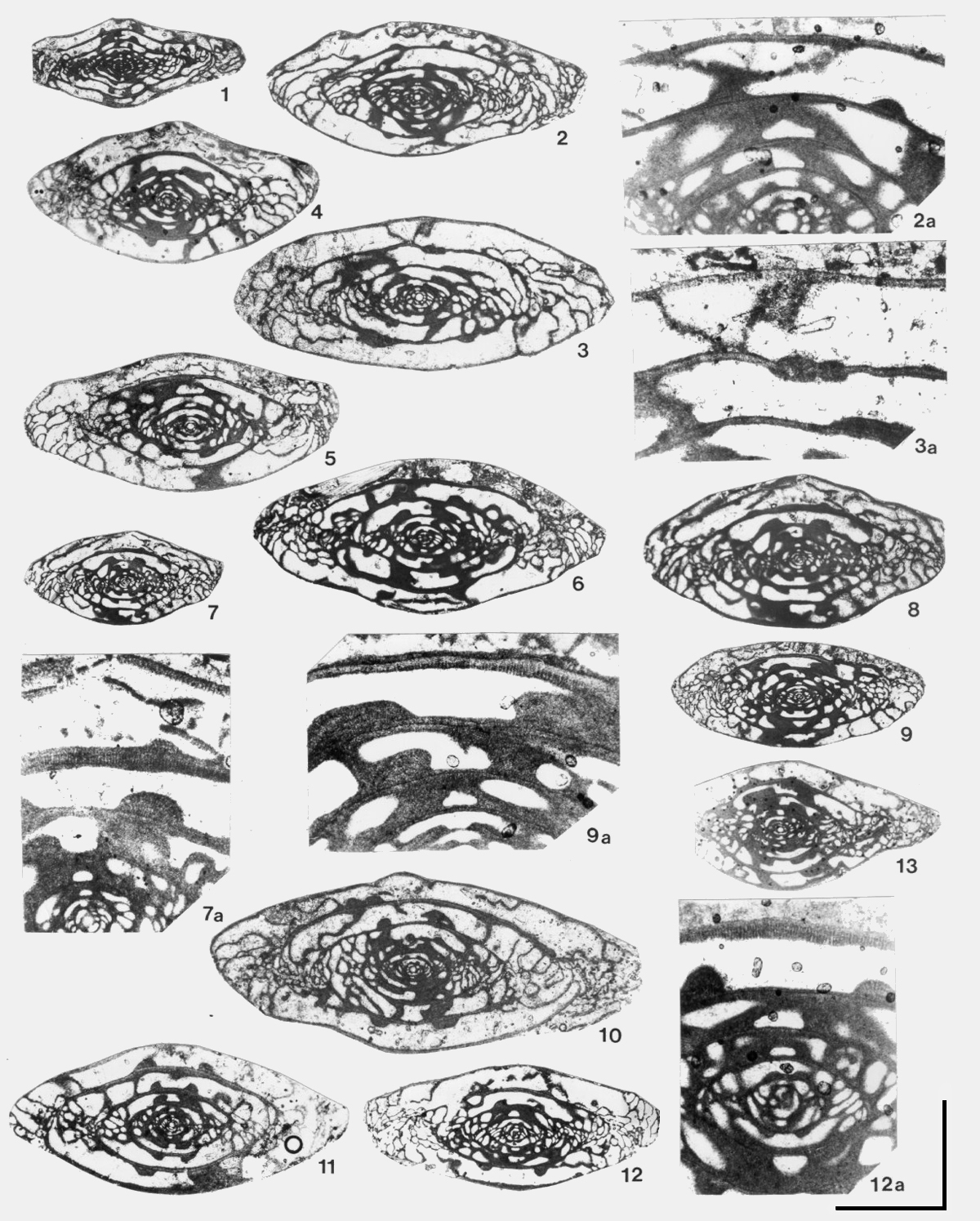
Figure 9.1-14. Fusulinid assemblage of Montiparus montiparus Zone. 1. Protriticites ovoides Putrja 1948, scale bar = 22mm, axial section, bed 95.5 m, (PMO-43854/Ca). 2. Elongate specimen transitional from Protriticites to Montiparus, which probably formed lineage of elongate Montiparus, scale bar = 22mm, axial section, bed 95.5 m, (PMO-43854/21a). 3. Subspherical specimen transitional from Protriticites to Montiparus, which probably formed lineage of subspherical Montiparus, scale bar = 22mm, axial section, bed 95.5 m, (PMO-43854/26a). 4-6. Montiparus montiparus (Ehrenberg em. Moeller 1878), scale bar = 22mm, all axial sections, bed 95.5 m, 4, (PMO-43854/23a); 5, (PMO-43854/31a). 6, (PMO-43854/24a). 7-11. Montiparus likharevi (Putrja 1939), scale bar = 22mm, all axial sections, bed 95.5 m, 7, (PMO-43854/27a); 7a, enlargement of figure 10-7, thick wall typical for the Schwagerinidae contains dark tectum, keriotheca and fragmentally developed outer tectorium; 8, (PMO-43854/22a); 9, (PMO-43854/19a); 10, (PMO-43854/32a); 11, (PMO-43854/34a). 12. Montiparus umbonoplicatus (Rauser and Belyaev in Rauser-Chernousova, Belyaev, and Reitlinger 1936), scale bar = 22mm, axial section, bed 95.5 m, (PMO-43854/24a). 13-14. Montiparus mesopachus Rosovskaya 1950, scale bar = 22mm, both axial sections, bed 95.5 m, 13. (PMO-43854/30a); 14. (PMO-43854/13a); 14a, enlargement of figure 10-14, keriothecal wall present in all volutions; the wall is slightly recristallized.
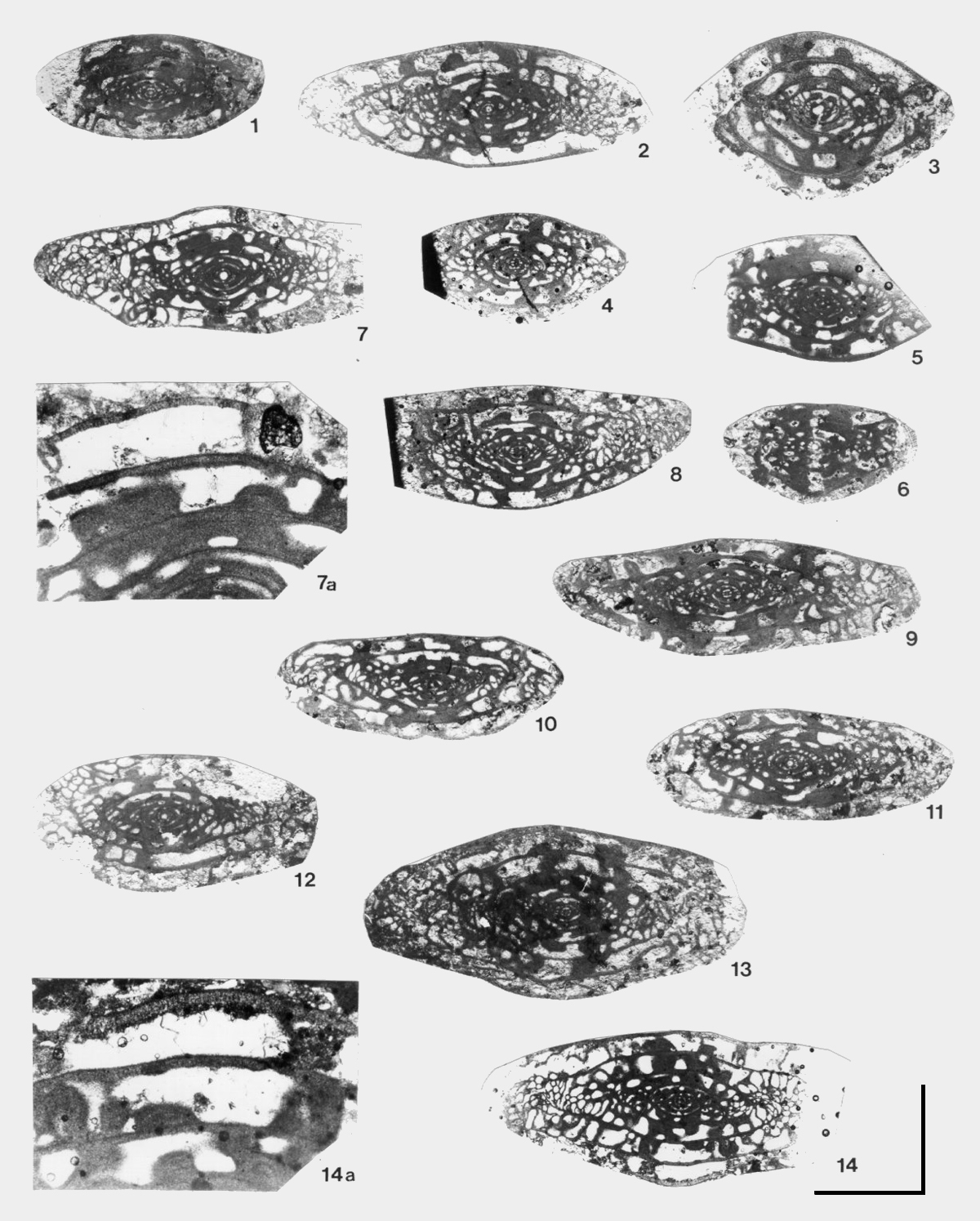
Figure 10. Correlation of fusulinid zones. Click on section of interest for zoom.

Figure 11. Comparative characteristic of the evolution trends of the Middle/Late Carboniferous of Russian-arctic and American fusulinids. Russian-arctic fusulinids.


